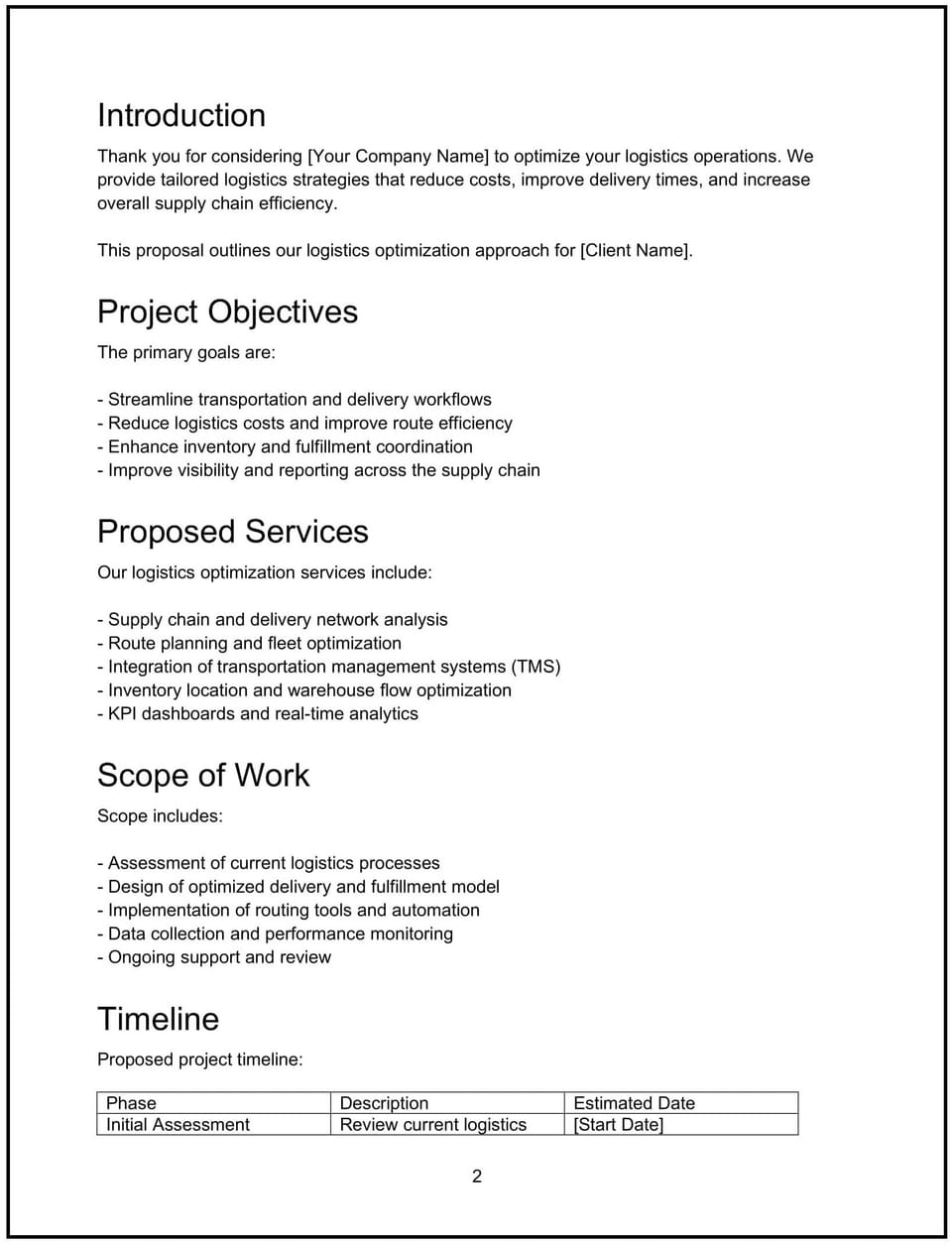Logistics optimization proposal: Free template

Customize this free logistics optimization proposal with Cobrief
Open this free logistics optimization proposal in Cobrief and start editing it instantly using AI. You can adjust the tone, structure, and content based on your offer, the client’s goals, and their current supply chain challenges. You can also use AI to review your draft — spot gaps, tighten language, and improve clarity before sending.
Once you're done, send, download, or save the proposal in one click — no formatting or setup required.
This template is fully customizable and built for real-world use — ideal for pitching supply chain improvements, process redesigns, or technology integrations that increase efficiency. Whether you’re creating proposals regularly or occasionally, this version gives you a structured head start and removes the guesswork.
What is a logistics optimization proposal?
A logistics optimization proposal is a document used to present solutions for improving a business’s logistics and supply chain performance. It outlines your understanding of current inefficiencies—such as delivery delays, high transportation costs, or inventory mismanagement—and recommends strategies to address them.
Typically shared after initial assessments or discussions, this proposal helps align stakeholders on goals, methodology, deliverables, timelines, and pricing.
A good logistics optimization proposal helps you:
- Clearly define the scope and objectives of the logistics project.
- Communicate the benefits of your recommended changes.
- Set expectations around implementation phases and outcomes.
- Move the client closer to approval and project kickoff.
Use this proposal when you want to offer clear, actionable strategies to improve logistics and supply chain effectiveness.
Why use Cobrief to edit your proposal
Cobrief gives you a faster, smarter way to customize and polish your proposal directly in your browser — with built-in AI to support your writing.
- Edit the proposal directly in your browser: No setup or formatting required — just click and start working.
- Rewrite sections with AI: Highlight any sentence and choose from smart rewrite options like simplify, rephrase, or change tone.
- Run a one-click AI review: Get actionable suggestions to improve flow, fix vague language, or fill in missing detail.
- Apply AI suggestions instantly: Review and accept individual AI suggestions, or apply all improvements across the proposal in one click.
- Share or export instantly: Send your proposal via Cobrief or download a clean PDF or DOCX file — ready to share with clients.
No formatting headaches, no guessing — just a clean, guided experience from start to finish.
When to use this proposal
This logistics optimization proposal works well in scenarios like:
- Reducing delivery times and improving order accuracy.
- Lowering transportation and warehousing costs.
- Streamlining supply chain workflows and communication.
- Implementing new technology such as TMS or WMS systems.
- Preparing for scale during peak seasons or expansion.
Use this proposal when you want to clearly communicate a roadmap for logistics improvements and cost savings.
What to include in a logistics optimization proposal
Each section in this template helps you communicate your offer clearly and professionally. Here's what to include — and how to tailor it:
- Executive summary: Concisely outline the client’s logistics challenges and your recommended approach.
- Project objectives: Define measurable goals such as faster delivery, reduced costs, or better inventory turnover.
- Solution strategy: Describe process changes, technology implementation, or vendor consolidation plans.
- Implementation timeline: Present phases, milestones, and key dates for rollout.
- Pricing: Clearly list your fees, whether fixed, hourly, or milestone-based, including what’s covered.
- Terms and conditions: Set expectations on payment, scope changes, and client responsibilities.
- Next steps: Provide a clear call to action for proposal approval, kickoff, or further discussion.
How to write an effective logistics optimization proposal
An effective logistics optimization proposal is detailed, data-driven, and client-focused. Here’s how to improve yours:
- Use client-specific data: Reference known pain points and performance metrics when possible.
- Explain solutions clearly: Avoid jargon and outline benefits in practical terms.
- Emphasize ROI: Highlight potential cost savings or efficiency gains.
- Set realistic timelines and expectations: Be clear about what can be achieved and when.
- Offer scalable options: Mention phased approaches or pilot projects.
- Close with a clear next step: Make it easy for clients to move forward confidently.
Frequently asked questions (FAQs)
How do I tailor this proposal to different industries?
Adjust the challenges, terminology, and solution focus to the client’s sector (e.g., retail, manufacturing, e-commerce).
What pricing models work best?
Fixed-price projects, hourly consulting, or phased billing are common. Clarify deliverables tied to payments.
Can this include technology recommendations?
Yes — you can propose software tools, automation, or integration services as part of your solution.
How should I address remote vs onsite work?
Clearly define your availability and preferred methods for assessments, training, or implementation support.
Can I export this proposal for client review?
Yes. After editing, export a professionally formatted PDF or Word document for sharing.
This article contains general legal information and does not contain legal advice. Cobrief is not a law firm or a substitute for an attorney or law firm. The law is complex and changes often. For legal advice, please ask a lawyer.